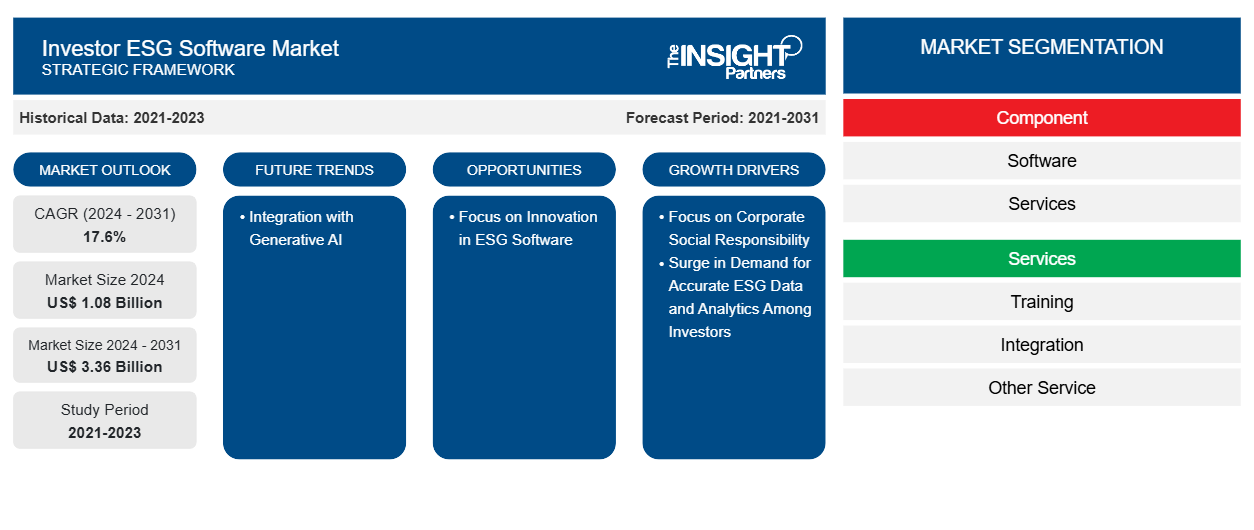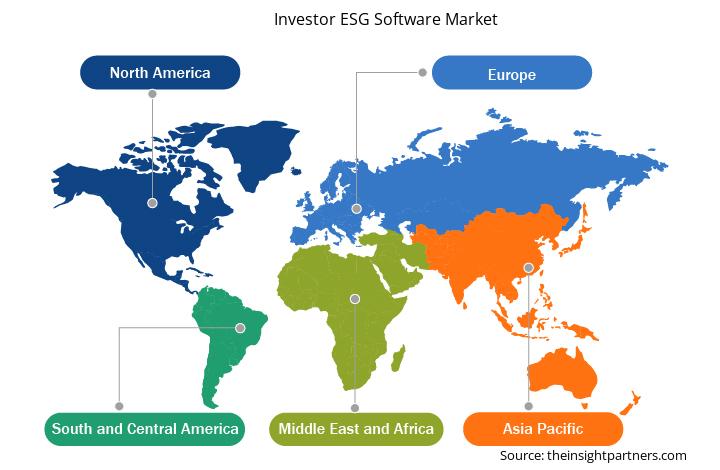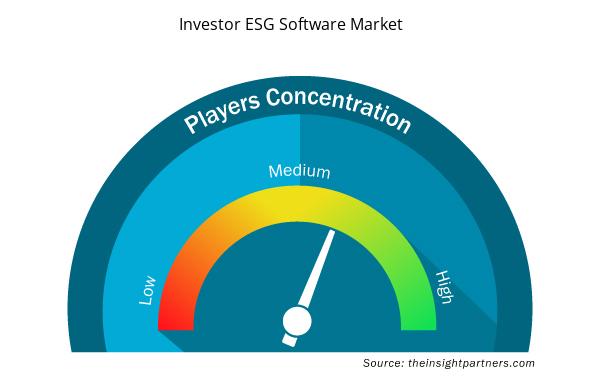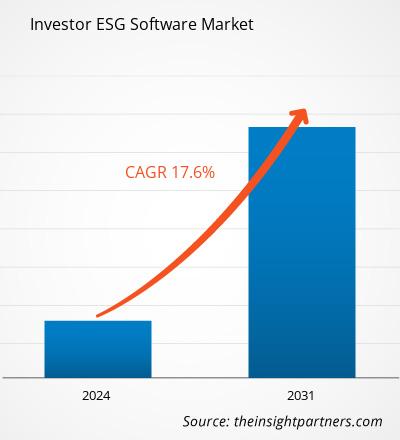La dimensione del mercato del software ESG per investitori è stata valutata a 1,08 miliardi di dollari USA nel 2024 e si prevede che raggiungerà i 3,36 miliardi di dollari USA entro il 2031; si stima che registrerà un CAGR del 17,6% dal 2024 al 2031. È probabile che l'integrazione del software ESG con l'intelligenza artificiale generativa porti nuove tendenze sul mercato nei prossimi anni.
Analisi di mercato del software ESG per gli investitori
Il mercato del software ESG per investitori ha assistito a una crescita significativa dovuta alla crescente domanda di investimenti responsabili, alle crescenti preoccupazioni sui cambiamenti climatici, alle questioni sociali e alle pratiche di governance, nonché alla necessità di trasparenza e conformità con gli standard ESG globali in evoluzione. La domanda di software ESG per investitori è guidata da investitori istituzionali, gestori patrimoniali e istituzioni finanziarie che cercano di integrare i fattori ESG nei loro processi decisionali. Fattori come l'attenzione alla responsabilità sociale d'impresa e la crescente domanda degli investitori di dati e analisi ESG accurati stanno anche guidando il mercato del software ESG per investitori. Inoltre, l'attenzione all'innovazione nel software ESG e l'integrazione con l'intelligenza artificiale generativa stanno creando opportunità redditizie per la crescita degli operatori del mercato del software ESG per investitori durante il periodo di previsione.
Panoramica del mercato del software ESG per gli investitori
Le organizzazioni utilizzano software ESG per investitori per personalizzare questionari e semplificare la raccolta dati, consentendo l'aggregazione di metriche di performance ESG precise e comparabili. Questa piattaforma software-as-a-service migliora le iniziative ESG, aiutando le aziende a massimizzare il valore e valutare gli investimenti. L'investimento ESG, o investimento sostenibile, si concentra sull'identificazione di fattori che definiscono investimenti responsabili, sostenibili o etici. Il software ESG è utilizzato sia dagli investitori che dalle società del mercato dei capitali per valutare i comportamenti aziendali, fornendo approfondimenti per prevedere le future performance finanziarie. Molte aziende implementano queste soluzioni software per mitigare i rischi correlati alle loro operazioni, relazioni commerciali, asset e investimenti
Le piattaforme ESG supportano l'analisi degli investimenti, fornendo decisioni di investimento più informate e strategiche. Il software Investor ESG è personalizzato per aiutare gli investitori a valutare, tracciare e gestire le performance ESG dei loro portafogli e delle loro decisioni di investimento. Queste piattaforme forniscono approfondimenti basati sui dati, analisi e reportistica su varie metriche ESG, consentendo agli investitori di allineare le loro strategie di investimento con gli obiettivi di sostenibilità e i requisiti normativi.
Personalizza questo report in base alle tue esigenze
Riceverai la personalizzazione gratuita di qualsiasi report, comprese parti di questo report, o analisi a livello nazionale, pacchetto dati Excel, oltre a usufruire di grandi offerte e sconti per start-up e università
Mercato del software ESG per gli investitori: approfondimenti strategici

- Scopri le principali tendenze di mercato in questo rapporto.Questo campione GRATUITO includerà analisi di dati che spaziano dalle tendenze di mercato alle stime e alle previsioni.
Driver e opportunità del mercato del software ESG per gli investitori
Attenzione alla responsabilità sociale d'impresa
L'emanazione della direttiva sulla rendicontazione della sostenibilità aziendale (CSRD) rappresenta un importante cambiamento normativo che guida in modo significativo la domanda di software ESG per investitori. La CSRD, che ha sostituito la direttiva sulla rendicontazione non finanziaria (NFRD) nel gennaio 2023, amplia notevolmente l'ambito della rendicontazione ESG obbligatoria all'interno dell'Unione Europea. Ai sensi della NFRD, circa 11.000 grandi aziende erano tenute a divulgare informazioni ESG. Tuttavia, la CSRD estende questo obbligo a circa 50.000 aziende, che rappresentano circa il 75% del fatturato totale di tutte le aziende dell'UE. Ciò include grandi aziende e piccole e medie imprese (PMI) quotate, ampliando in modo significativo l'ambito delle divulgazioni ESG e dei requisiti di conformità. La CSRD impone alle aziende di divulgare informazioni dettagliate in materia sociale, ambientale e di governance, che coprono aree quali diritti umani, rischi climatici, biodiversità e trasparenza della catena di fornitura. Questo quadro di rendicontazione completo garantisce che le aziende affrontino e mitighino gli impatti negativi sull'ambiente e sui diritti umani in Europa e in altre regioni. Con l'applicazione di queste nuove regole, la CSRD mira a migliorare la coerenza, la comparabilità e l'affidabilità dei dati ESG, rendendoli più trasparenti e accessibili agli investitori, agli enti regolatori e al pubblico in generale.
Focus sull'innovazione nel software ESG
Si prevede che l'attenzione all'innovazione nel software ESG creerà numerose opportunità per la crescita del mercato del software ESG per gli investitori durante il periodo di previsione. Poiché la domanda di dati ESG trasparenti, accurati e fruibili continua ad aumentare, gli investitori si affidano sempre di più a soluzioni software ESG avanzate per prendere decisioni di investimento informate. Il panorama in evoluzione dei fattori ambientali, sociali e di governance (ESG) richiede agli investitori di accedere a informazioni complete e in tempo reale che possono essere fornite solo da strumenti software innovativi. L'innovazione nel software ESG comporta l'integrazione di tecnologie all'avanguardia come l'intelligenza artificiale (IA), che stanno rimodellando il modo in cui i dati ESG vengono raccolti, elaborati e analizzati. Ad esempio, nell'aprile 2024, il fornitore di soluzioni di dati ESG ESGgo ha annunciato il lancio del suo One-Click Sustainability Report, uno strumento basato sull'IA progettato per aiutare le aziende a generare senza sforzo report di sostenibilità in linea con i quadri normativi e le aspettative degli stakeholder. ESGgo afferma che questa nuova soluzione semplifica il processo di reporting sulla sostenibilità per le organizzazioni, garantendo la conformità con standard in evoluzione. Il motore dati basato sull'intelligenza artificiale della piattaforma elabora informazioni numeriche e testuali, calcola le emissioni e sintetizza set di dati per creare report di sostenibilità personalizzati. Questi progressi consentono agli investitori di monitorare le performance di sostenibilità di un'azienda in modo più efficiente e di prevedere futuri rischi ed opportunità ESG in base a dati in tempo reale. La capacità di elaborare grandi quantità di dati, spesso provenienti da fonti diverse, e di sintetizzarli in metriche ESG praticabili è un vantaggio significativo per gli investitori che cercano trasparenza e affidabilità.
Analisi della segmentazione del rapporto di mercato del software ESG per gli investitori
I segmenti chiave che hanno contribuito alla derivazione dell'analisi di mercato del software ESG per gli investitori sono componenti, servizi e dimensioni aziendali.
- In base al componente, il mercato del software ESG per gli investitori è diviso in software e servizi. Il segmento software ha dominato il mercato nel 2024.
- In termini di servizi, il mercato del software ESG per gli investitori è segmentato in formazione, integrazione e altri servizi. Il segmento degli altri servizi ha detenuto la quota maggiore del mercato nel 2024.
- Sulla base delle dimensioni aziendali, il mercato del software ESG per investitori è suddiviso in grandi aziende e PMI. Il segmento delle grandi aziende ha dominato il mercato nel 2024.
Analisi della quota di mercato del software ESG per investitori in base all'area geografica
- Il mercato del software ESG per investitori è suddiviso in cinque regioni principali: Nord America, Europa, Asia Pacifico (APAC), Medio Oriente e Africa (MEA) e Sud e Centro America. Il Nord America ha dominato il mercato nel 2024, seguito da Europa e Asia Pacifico.
- Si prevede che il mercato del software ESG per investitori in Nord America crescerà durante il periodo di previsione a causa dei maggiori requisiti legali, come le proposte di divulgazione climatica della Securities and Exchange Commission (SEC) degli Stati Uniti. Questi obblighi legali creano pressione sui gestori patrimoniali e sugli investitori istituzionali per affrontare le preoccupazioni e le regole ESG nei loro processi decisionali. Inoltre, la crescente enfasi sulla sostenibilità e le crescenti preoccupazioni sui cambiamenti climatici creano domanda di software ESG tra investitori e stakeholder per informazioni chiare e basate sui dati. Queste informazioni li supportano nella valutazione efficace delle prestazioni ESG delle aziende. Il software fornisce maggiore responsabilità alle aziende consentendo la rendicontazione ESG in tempo reale, il monitoraggio della conformità e la valutazione del rischio.
- I governi di vari paesi in Europa stanno adottando misure come il Sustainable Finance Disclosure Regulation (SFDR) e il EU Taxonomy Regulation che promuovono la sostenibilità tra le operazioni aziendali. Questi requisiti richiedono ai gestori patrimoniali e agli investitori istituzionali di divulgare e valutare l'impatto ESG dei loro investimenti, il che aumenta l'adozione di software ESG tecnologicamente avanzati che consentono la conformità e la gestione dei dati. Inoltre, gli investitori europei hanno ampliato i loro investimenti sostenibili per supportare gli obiettivi del Green Deal della regione, il che aumenta la domanda di software ESG per gli investitori che aiuti a gestire i dati e a prendere decisioni informate.
Approfondimenti regionali sul mercato del software ESG per gli investitori
Le tendenze regionali e i fattori che influenzano l'Investor ESG Software Market durante il periodo di previsione sono stati ampiamente spiegati dagli analisti di Insight Partners. Questa sezione discute anche i segmenti e la geografia dell'Investor ESG Software Market in Nord America, Europa, Asia Pacifico, Medio Oriente e Africa e Sud e Centro America.

- Ottieni i dati specifici regionali per il mercato del software ESG per investitori
Ambito del rapporto di mercato del software ESG per gli investitori
| Attributo del report | Dettagli |
|---|---|
| Dimensioni del mercato nel 2024 | 1,08 miliardi di dollari USA |
| Dimensioni del mercato entro il 2031 | 3,36 miliardi di dollari USA |
| CAGR globale (2024 - 2031) | 17,6% |
| Dati storici | 2021-2023 |
| Periodo di previsione | 2021-2031 |
| Segmenti coperti | Per componente
|
| Regioni e Paesi coperti | America del Nord
|
| Leader di mercato e profili aziendali chiave |
|
Densità dei player del mercato del software ESG per gli investitori: comprendere il suo impatto sulle dinamiche aziendali
Il mercato del software ESG per investitori sta crescendo rapidamente, spinto dalla crescente domanda degli utenti finali dovuta a fattori quali l'evoluzione delle preferenze dei consumatori, i progressi tecnologici e una maggiore consapevolezza dei vantaggi del prodotto. Con l'aumento della domanda, le aziende stanno ampliando le loro offerte, innovando per soddisfare le esigenze dei consumatori e capitalizzando sulle tendenze emergenti, il che alimenta ulteriormente la crescita del mercato.
La densità degli operatori di mercato si riferisce alla distribuzione di aziende o società che operano in un particolare mercato o settore. Indica quanti concorrenti (operatori di mercato) sono presenti in un dato spazio di mercato in relazione alle sue dimensioni o al valore di mercato totale.
Le principali aziende che operano nel mercato del software ESG per gli investitori sono:
- MSCI
- Società a responsabilità limitata
- Società quotata in borsa Morningstar Inc.
- Gruppo della Borsa di Londra plc
- Cority Software Inc
- Società di software Prophix Inc.
Disclaimer : le aziende elencate sopra non sono classificate secondo un ordine particolare.

- Ottieni la panoramica dei principali attori del mercato del software ESG per investitori
Notizie di mercato e sviluppi recenti del software ESG per gli investitori
Il mercato del software ESG per investitori viene valutato raccogliendo dati qualitativi e quantitativi dopo la ricerca primaria e secondaria, che include importanti pubblicazioni aziendali, dati associativi e database. Di seguito sono elencati alcuni degli sviluppi nel mercato del software ESG per investitori:
- Cority ha annunciato che tutti i clienti che sfruttano una delle sue soluzioni di sostenibilità saranno aggiornati alla piattaforma CorityOne integrata e basata su SaaS dell'azienda nel 2025. Basato sulla tecnologia esistente a cui i clienti si affidano da oltre un decennio per la gestione della sostenibilità, questo aggiornamento unirà più soluzioni in un'esperienza utente fluida e migliorata con funzionalità elevate, semplificando ulteriormente le operazioni e migliorando l'integrazione dei dati.
(Fonte: Cority Software Inc, comunicato stampa, agosto 2024)
- Sphera ha annunciato l'acquisizione di SupplyShift, un'azienda di software per la sostenibilità della supply chain che consente alle aziende di creare supply chain trasparenti, responsabili e resilienti. L'acquisizione potenzia l'offerta di supply chain dell'azienda leader in ambito ESG con funzionalità ampliate di mappatura dei fornitori, punteggio e tracciabilità per consentire ai clienti di creare supply chain sostenibili.
(Fonte: Sphera Solutions, Inc., Comunicato stampa, gennaio 2024)
Copertura e risultati del rapporto di mercato del software ESG per gli investitori
"Dimensioni e previsioni del mercato del software ESG per investitori (2021-2031)" fornisce un'analisi dettagliata del mercato che copre le aree menzionate di seguito:
- Dimensioni e previsioni del mercato del software ESG per gli investitori a livello globale, regionale e nazionale per tutti i segmenti di mercato chiave coperti dall'ambito
- Tendenze del mercato del software ESG per gli investitori, nonché dinamiche di mercato quali driver, vincoli e opportunità chiave
- Analisi PEST e SWOT dettagliate
- Analisi di mercato del software ESG per investitori che copre le principali tendenze di mercato, il quadro globale e regionale, i principali attori, le normative e i recenti sviluppi del mercato
- Analisi del panorama industriale e della concorrenza che copre la concentrazione del mercato, l'analisi della mappa di calore, i principali attori e gli sviluppi recenti per il mercato del software ESG per gli investitori
- Profili aziendali dettagliati
- Analisi storica (2 anni), anno base, previsione (7 anni) con CAGR
- Analisi PEST e SWOT
- Valore/volume delle dimensioni del mercato - Globale, regionale, nazionale
- Industria e panorama competitivo
- Set di dati Excel


- Malaria Treatment Market
- Microcatheters Market
- Emergency Department Information System (EDIS) Market
- Oxy-fuel Combustion Technology Market
- Embolization Devices Market
- Tortilla Market
- Sweet Potato Market
- Water Pipeline Leak Detection System Market
- Non-Emergency Medical Transportation Market
- Fishing Equipment Market

Report Coverage
Revenue forecast, Company Analysis, Industry landscape, Growth factors, and Trends

Segment Covered
This text is related
to segments covered.

Regional Scope
North America, Europe, Asia Pacific, Middle East & Africa, South & Central America

Country Scope
This text is related
to country scope.
Domande frequenti
Focus on corporate social responsibility, and surge in demand for accurate ESG data and analytics among investors are the major factors that propel the global investor ESG software market.
The global investor ESG software market is expected to reach US$ 3.36 billion by 2031.
The global Investor ESG software market was estimated to be US$ 1.08 billion in 2024 and is expected to grow at a CAGR of 17.6% during the forecast period 2025 – 2031.
The key players holding majority shares in the global investor ESG software market are MSCI, FactSet, Workiva Inc., SAP SE, and Bloomberg Finance L.P.
The incremental growth expected to be recorded for the global investor ESG software market during the forecast period is US$ 2.27 billion.
Integration with Generative AI is anticipated to play a significant role in the global investor ESG software market in the coming years.
Trends and growth analysis reports related to Technology, Media and Telecommunications : READ MORE..
The List of Companies - Investor ESG Software Market
- MSCI
- Workiva Inc.
- Morningstar Sustainalytics
- London Stock Exchange Group plc
- Cority
- Prophix Software Inc.
- SAP SE
- Sphera
- FactSet
- Bloomberg Finance L.P.
The Insight Partners performs research in 4 major stages: Data Collection & Secondary Research, Primary Research, Data Analysis and Data Triangulation & Final Review.
- Data Collection and Secondary Research:
As a market research and consulting firm operating from a decade, we have published and advised several client across the globe. First step for any study will start with an assessment of currently available data and insights from existing reports. Further, historical and current market information is collected from Investor Presentations, Annual Reports, SEC Filings, etc., and other information related to company’s performance and market positioning are gathered from Paid Databases (Factiva, Hoovers, and Reuters) and various other publications available in public domain.
Several associations trade associates, technical forums, institutes, societies and organization are accessed to gain technical as well as market related insights through their publications such as research papers, blogs and press releases related to the studies are referred to get cues about the market. Further, white papers, journals, magazines, and other news articles published in last 3 years are scrutinized and analyzed to understand the current market trends.
- Primary Research:
The primarily interview analysis comprise of data obtained from industry participants interview and answers to survey questions gathered by in-house primary team.
For primary research, interviews are conducted with industry experts/CEOs/Marketing Managers/VPs/Subject Matter Experts from both demand and supply side to get a 360-degree view of the market. The primary team conducts several interviews based on the complexity of the markets to understand the various market trends and dynamics which makes research more credible and precise.
A typical research interview fulfils the following functions:
- Provides first-hand information on the market size, market trends, growth trends, competitive landscape, and outlook
- Validates and strengthens in-house secondary research findings
- Develops the analysis team’s expertise and market understanding
Primary research involves email interactions and telephone interviews for each market, category, segment, and sub-segment across geographies. The participants who typically take part in such a process include, but are not limited to:
- Industry participants: VPs, business development managers, market intelligence managers and national sales managers
- Outside experts: Valuation experts, research analysts and key opinion leaders specializing in the electronics and semiconductor industry.
Below is the breakup of our primary respondents by company, designation, and region:

Once we receive the confirmation from primary research sources or primary respondents, we finalize the base year market estimation and forecast the data as per the macroeconomic and microeconomic factors assessed during data collection.
- Data Analysis:
Once data is validated through both secondary as well as primary respondents, we finalize the market estimations by hypothesis formulation and factor analysis at regional and country level.
- Macro-Economic Factor Analysis:
We analyse macroeconomic indicators such the gross domestic product (GDP), increase in the demand for goods and services across industries, technological advancement, regional economic growth, governmental policies, the influence of COVID-19, PEST analysis, and other aspects. This analysis aids in setting benchmarks for various nations/regions and approximating market splits. Additionally, the general trend of the aforementioned components aid in determining the market's development possibilities.
- Country Level Data:
Various factors that are especially aligned to the country are taken into account to determine the market size for a certain area and country, including the presence of vendors, such as headquarters and offices, the country's GDP, demand patterns, and industry growth. To comprehend the market dynamics for the nation, a number of growth variables, inhibitors, application areas, and current market trends are researched. The aforementioned elements aid in determining the country's overall market's growth potential.
- Company Profile:
The “Table of Contents” is formulated by listing and analyzing more than 25 - 30 companies operating in the market ecosystem across geographies. However, we profile only 10 companies as a standard practice in our syndicate reports. These 10 companies comprise leading, emerging, and regional players. Nonetheless, our analysis is not restricted to the 10 listed companies, we also analyze other companies present in the market to develop a holistic view and understand the prevailing trends. The “Company Profiles” section in the report covers key facts, business description, products & services, financial information, SWOT analysis, and key developments. The financial information presented is extracted from the annual reports and official documents of the publicly listed companies. Upon collecting the information for the sections of respective companies, we verify them via various primary sources and then compile the data in respective company profiles. The company level information helps us in deriving the base number as well as in forecasting the market size.
- Developing Base Number:
Aggregation of sales statistics (2020-2022) and macro-economic factor, and other secondary and primary research insights are utilized to arrive at base number and related market shares for 2022. The data gaps are identified in this step and relevant market data is analyzed, collected from paid primary interviews or databases. On finalizing the base year market size, forecasts are developed on the basis of macro-economic, industry and market growth factors and company level analysis.
- Data Triangulation and Final Review:
The market findings and base year market size calculations are validated from supply as well as demand side. Demand side validations are based on macro-economic factor analysis and benchmarks for respective regions and countries. In case of supply side validations, revenues of major companies are estimated (in case not available) based on industry benchmark, approximate number of employees, product portfolio, and primary interviews revenues are gathered. Further revenue from target product/service segment is assessed to avoid overshooting of market statistics. In case of heavy deviations between supply and demand side values, all thes steps are repeated to achieve synchronization.
We follow an iterative model, wherein we share our research findings with Subject Matter Experts (SME’s) and Key Opinion Leaders (KOLs) until consensus view of the market is not formulated – this model negates any drastic deviation in the opinions of experts. Only validated and universally acceptable research findings are quoted in our reports.
We have important check points that we use to validate our research findings – which we call – data triangulation, where we validate the information, we generate from secondary sources with primary interviews and then we re-validate with our internal data bases and Subject matter experts. This comprehensive model enables us to deliver high quality, reliable data in shortest possible time.

 Ottieni un campione gratuito per questo repot
Ottieni un campione gratuito per questo repot